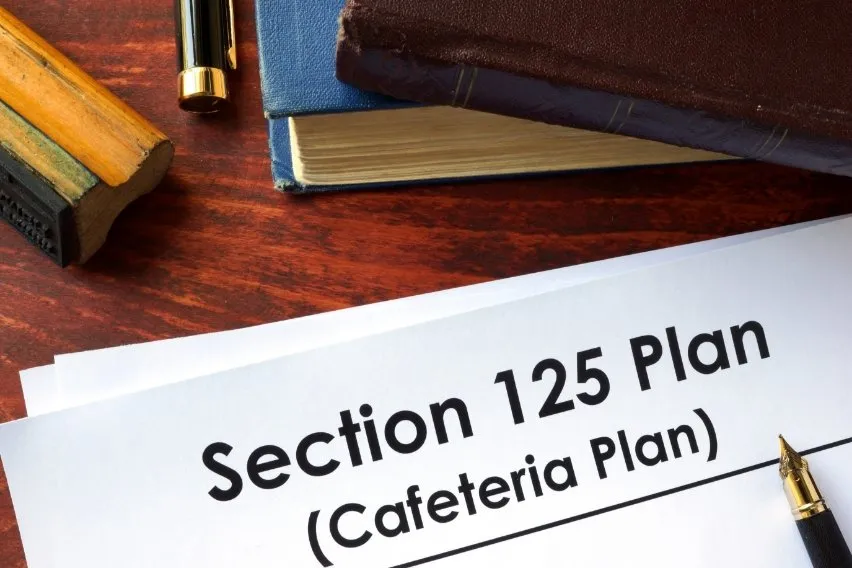Section 125 (Or Cafeteria) Plan: Types and Benefits

Giving key employees a benefits package that is both affordable and appealing can be difficult for many firms. Despite the fact that rising healthcare prices have an impact on benefit costs, a section 125 plan, often known as a cafeteria plan, enables you to increase employee benefits without going over budget because of its considerable tax savings.
Section 125 plans are a fringe benefit that employers who want to compete for the best talent can use to entice and retain workers. A cafeteria plan, when implemented properly, can boost an employee’s take-home pay without affecting their remuneration.
Read on as we take a closer look at everything to do with a Section 125 plan. Including the different types, who can open one, the qualified benefits, and what expenses are covered.
Table of Contents
What Is a Section 125 (Or Cafeteria) Plan?
Who Can Open a Section 125 Plan?
Expenses Covered in Section 125 Plan
How Do You Set up a Section 125 Plan?
Can You Change a Cafeteria Plan?
What Is a Section 125 (Or Cafeteria) Plan?
A Section 125 plan is a provision of the Internal Revenue Service (IRS) law that permits employees to convert taxable benefits, like a cash salary, into nontaxable benefits. Before taxes are paid, these perks may be taken out of the paycheck of an employee. Participants who often incur costs for child care and medical concerns benefit most from these programs.
Section 125 is also known as a cafeteria plan.
Employees who participate in a Section 125 plan have the option to prepay insurance premiums and any further expenses that can later be used for certain child care and qualified medical costs.
Any employees that take part in this plan can save between 28% and 48% in cumulative local, state, and federal taxes. This is on a range of things that they generally already buy with their own money after taxes, depending on where in the country they reside.
Employers can reduce their portion of payroll taxes by an additional 7.65%.

Types of Section 125 Plans
There are a few different types of Section 125 plans. Typical examples of cafeteria plans include:
Premium Only Plans (POP)
The pretax contributions made by an employee under this type of plan may only be used to pay the premiums for group health insurance.
Flexible Savings Arrangements (FSA)
Pretax funds are saved by employees who participate in an FSA and can be used to pay for certain medical expenses. Such plans have an annual cap on contributions, and any funds left over at the end of the calendar year are forfeited.
Simple Cafeteria Plans
If they offer the same benefit payments to every eligible employee, employers with 100 workers or fewer are exempt from the plan non-discrimination requirements.
Full Flex Plans
Benefits are purchased by qualified employees with company contributions. The employee may use pretax payroll deductions to cover any benefit that isn’t fully provided by the company.
Who Can Open a Section 125 Plan?
An employer must design and open Section 125 plans. This is employers that include:
- Government entities
- Sole proprietorships
- C corporations
- S corporations
- LLCs
- Partnerships
Benefits are made available to the employees of a company, their married partners, as well as their dependents when a plan is established. Former employees may potentially be eligible for Section 125 benefits. Although this is dependent on the specifics of the cafeteria plan, this also cannot be the plan’s primary purpose.
However, not every employee who works for the company is eligible to take part in the plan. A section 125 plan is not open to non-employees, including:
- 1099 contractors
- Individuals who hold more than 2% of the S corporation,
- LLC members
- Partnership partners
Benefits of Section 125 Plan
Benefits to Employer
Section 125 plans have a variety of tax-saving advantages for employers. Employers save money on workers’ compensation insurance premiums, the Federal Insurance Contributions Act (FICA) tax, the Federal Unemployment Tax Act (FUTA) tax, and the State Unemployment Tax Act (SUTA) tax for each member in the plan.
The Section 125 plan typically pays for itself. This is since the expense of actually opening the plan is cheap when paired with the additional tax savings.
The fact that employees get a rise without the firm having to pay more is an extra bonus. The company is frequently urged to make a contribution to each individual employee’s plan in order to encourage higher participation by individuals who are not yet enrolled in the Section 125 plan, as more members in the plan amount to further tax savings for the employer.
Benefits to Employee
The main advantage for employees is also very much tax-related. Anyone participating in the plan can typically anticipate saving 20% – 40% of each and every dollar invested in the plan.
Each year, the employee must pick how much money to contribute to the plan. Every payment cycle, an automatic deduction for the “election” amount is made from the paycheck of the employee.
If an employee chooses to have $1200 per year withheld from their paycheck and invested in the plan, for instance, and the business has 24 separate pay periods, $50 is automatically and tax-free withheld from each pay period.
The third-party administrator of the plan receives and holds the funds. On request, it is then given out for repayment of acceptable expenses.
Expenses Covered in Section 125 Plan
Under a Section 125 plan, a wide range of child care and medical expenses are available for reimbursement. Numerous qualified expenses for medical supplies and procedures are eligible for reimbursement.
Expenses that qualify for this include:
- Ambulance services
- Birth control
- Chiropractic care
- Dental and physician fees
- Eye exams
- Fertility treatments
- Hearing aids
- Long-term care services
- Nursing homes
- Operations
- Prescription drugs
- Psychiatric services
- Sterilization
- Wigs
- Wheelchairs
There are also many different qualifying over-the-counter products available such as:
- Prenatal vitamins
- Orthopedic shoes
- Allergy medications
- Cold remedies
- Contact lens solutions
- First aid supplies
- Painkillers
- Pregnancy tests
- Sleeping pills
- Throat lozenges
- Sunscreen
In summary, the benefits that are included in Section 125 Plan include:
- Societal health advantages
- Coverage for accidents and disabilities
- Adoption support
- Aid with dependent care
- Term life insurance for groups
- Health savings accounts (HSAs)
How Do You Set up a Section 125 Plan?
A Section 125 plan can be created in a fairly simple manner. An employer is required to carry out nondiscrimination testing, notify workers, and provide the appropriate documents.
The three nondiscrimination standards that must be passed by Section 125 plans are the:
- Eligibility to participate
- Benefits and contributions
- Concentration tests
These tests are used to assess whether the plan favors employees who earn a high wage or important employees of the company.
Different benefits are offered by cafeteria programmes. Employees may pay their fair share of insurance premiums. This is normally done on a pretax basis under a premium-only plan (POP). The out-of-pocket eligible expenditures can be paid pre tax under the flexible spending account (FSA) version, which is the design of the above-described plan.
The comprehensive plan, known as a consumer-driven healthcare (CDHC) plan, includes a credit system that the employee may utilize at their discretion for permissible costs. Then, employees can use their own funds to complement the CDHC and purchase other perks or coverage.
Employers are required to work with a competent Section 125 third-party administrator that can offer the most recent documents for establishing a plan and keep the employer informed of the most recent compliance requirements.
Typical services provided by third-party administrators to employers include:
- A current plan document
- Summary plan descriptions
- Corporate resolution
- Any customized forms
- Legal review
- Attorney opinion letters
- Discriminatory practices testing
- A signatory-ready Form 5500 if it is required
- Employee education
Can You Change a Cafeteria Plan?
Except in the case of a qualifying life event, employees who have already enrolled in a cafeteria plan and made their selections often cannot change them. This is normal until the following open enrollment period.
A qualifying life event counts as the following events:
- Marriage, divorce or legal separation
- Adoption or childbirth
- Involuntary loss of coverage under another plan
- Your employment status changing
- Going past the age limit of a parent’s plan
These circumstances do not suffice in and of themselves to support a special open enrollment. Employees typically need to show proof of their eligibility in the form of a marriage licence, birth certificate, letter from an insurance company, or other legal document.

Key Takeaways
Today’s workers place a high importance on having a choice of flexible health benefits that enhance their welfare and the wellbeing of their families. Because they enable companies to provide eligible benefits that draw and keep talent while lowering their own and their employees’ tax obligations, section 125 plans continue to be popular.
To choose the best plan for them and make sure they adhere to Affordable Care Act rules, employers should discuss their options with benefits administrators. As well as gain the advice of legal counsel.
FAQS on Section 125
Who Needs a Section 125 Plan?
Pre-taxed employee benefits are required by the IRS. Yes, a Section 125 plan document is required if you’re an employer that wants to permit salary deductions from employees’ pre-tax wages to be used to pay for group health as well as other insurance premiums.
What Is the Difference Between Section 125 and HSA?
Employee contributions to a Section 125 HSA are collected as pre-tax payroll deductions in accordance with the election form filled out during open enrollment. Although monies placed into an HSA are instantly available to cover or repay eligible medical expenses, the yearly election amount is not pre-funded.
Who Is Not Eligible for the Section 125 Plan?
Some of the entities that are ineligible for the Section 125 plan include self-employed people, partners in a partnership, and people who possess more than 2% of a subchapter S corporation.
What Is the “Use It or Lose It” Policy?
It is a requirement of Section 125 plans that you use any remaining monies in the account at the end of the calendar year or forfeit them to your employer. It is possible for plan participants to carry over up to $500 of leftover funds from one year to the next. This is thanks to a carryover provision that was put in place in 2013.
RELATED ARTICLES


 Top 8 Payroll Software for Accountants
Top 8 Payroll Software for Accountants Wage Garnishment: What It Is & How It Works?
Wage Garnishment: What It Is & How It Works? What Is COBRA Insurance? Process, Pros & Cons
What Is COBRA Insurance? Process, Pros & Cons Bonus Pay: Definition, Types & Tips for Earning Bonus
Bonus Pay: Definition, Types & Tips for Earning Bonus Payroll Cost: How to Calculate & Factors that Affect Payroll Cost
Payroll Cost: How to Calculate & Factors that Affect Payroll Cost How to Do Payroll Yourself for Small Business
How to Do Payroll Yourself for Small Business